Two New Ions: ASUS AT3N7A-I and ASRock Ion 330
by Anand Lal Shimpi on August 28, 2009 12:00 AM EST- Posted in
- Motherboards
The Ion Performance Showdown
All of the benchmarks on the previous page were run under Windows Vista, but I actually spent most of my time using these Ions under Windows 7. As a quick sanity check I compared all three using PCMark Vantage to see if there were any performance differences at all. All three systems used the same 2 x 2GB DDR2-800 sticks, a 120GB Super Talent UltraDrive GX SSD and the same install of Windows 7 x64. We used NVIDIA's 15.41 chipset drivers, 190.62 GPU drivers and 10.000.55 HDMI drivers.
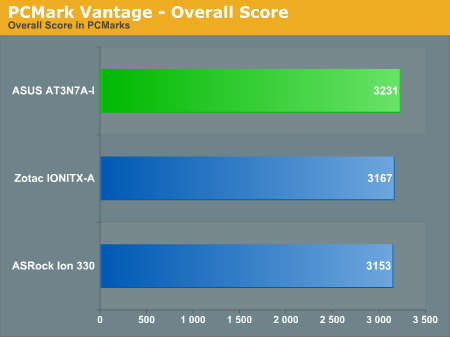

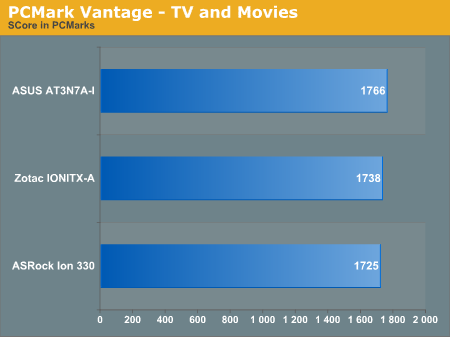

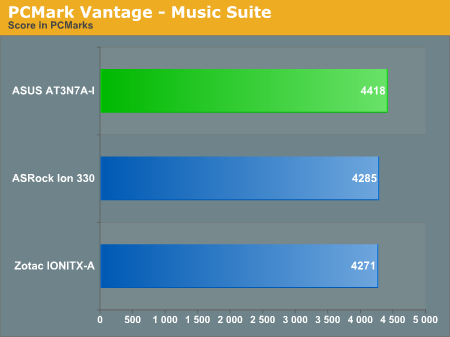
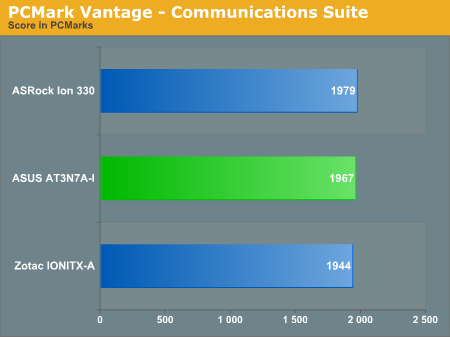
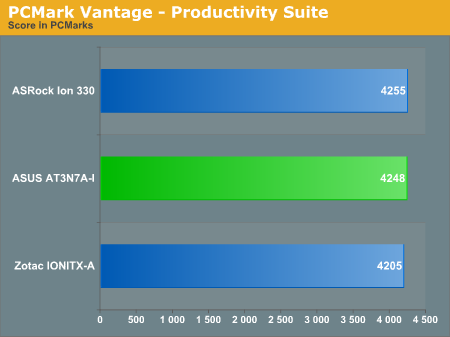
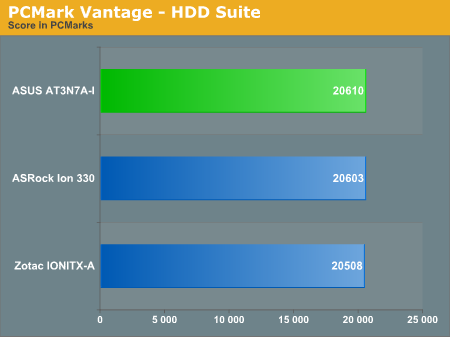
With the same CPU, same graphics and after I swapped in the same SSD into all three builds, the performance is obviously: the same. If we’re going to separate these things it’s going to be along some other vector.
I measured how long each of these machines took to boot:
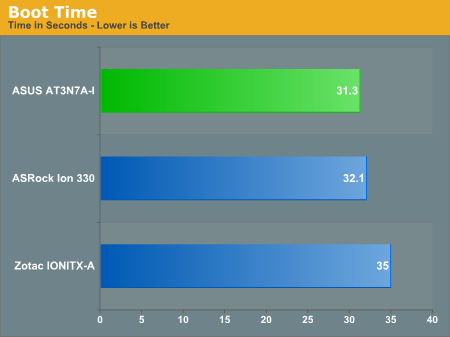
The ASUS was the quickest, although only the Zotac was noticeably slower here. Disabling ASUS' Express Gate pre-boot environment is absolutely necessary for a fast boot time. Before I disabled EG the board spent around 25 seconds POSTing before it started to launch Windows.










61 Comments
View All Comments
Titanius - Friday, August 28, 2009 - link
"While Acer offers the Aspire Revo, it only comes with a single-core Atom 230, a far less desirable option."What about the Acer Aspire Revo R3600? It has an Intel Atom 330, a 160GB HD and 2 GB of Dual-Channel RAM. Check it out: http://www.ncix.com/products/index.php?sku=41924&a...">http://www.ncix.com/products/index.php?...&man...
Fietsventje - Friday, August 28, 2009 - link
A pitty, no network interface benchmarks. Despite the overkill of the nVidia GPU, these boards would make the ideal start of a limited home server, and transferring files at gigabit speeds is no small feat for such a small processor ...mgrier - Friday, August 28, 2009 - link
Do you have data to support this? Between DMA both to the drive and the NIC and TCP checksum offloading, the CPU overhead of disk transfers should be minimal with an operating system and drivers that support all of the above. Assuming a single drive configuration, you should mostly be limited by transfer rate of the drive for large files. For smaller files, you should be limited by the drive's seek latency.JarredWalton - Saturday, August 29, 2009 - link
I'm not so sure it's the HDD CPU overhead so much as network drivers. I'd imaging these Atom CPUs could use a good 30-50% of the CPU for doing Gb transfers. However, as you are limited by the HDD to a maximum ~50MBps (unless you go SSD or at least a 7200RPM drive), you should probably only need 15-25% of the CPU. Would be interesting to see the results though. At least the Ion systems give you GbE, unlike all the netbooks I've tested.cliffman - Friday, August 28, 2009 - link
I am interested in seeing the performance of a mini-itx board that can support a quad core system. You can build a modern system for $500 instead of paying $350 for an atom system.MadMan007 - Sunday, August 30, 2009 - link
Considering those use any one of the regular LGA775 (atm - maybe we'll see some LGA1156 mITX boards) chipsets unless the board is just done poorly the performance would be the same as a full system with the same chipset and CPU. You'd just have the obvious tradeoff of expansion and possibly overclocking/enthusiast features.plext0r - Friday, August 28, 2009 - link
You mention the Acer Aspire Revo on the last page. Any word when and if Acer will release this box in the US? A single-core 230 is plenty of CPU horsepower for XBMC or MythTV when using Nvidia's binary drivers. Thanks!strikeback03 - Friday, August 28, 2009 - link
Hey, finally an Atom board with analog connections for more channels. Maybe I'll eventually replace the LF2 board in my carputer with this (and just keep the Scythe fan I already have).gipper - Friday, August 28, 2009 - link
Why in the world can't people just use bigger fixtures and bigger fans?It's like the xbox 360. Who cares if it's smaller than my receiver, it's A FREAKING JET ENGINE. Why can't they just bump the size up a bit and throw in a 120mm fan?
With these, what's wrong with bumping up the chasis to xbox1 size and going with a slower 80mm fan which will probably deliver more air flow at 800rpm than these 40mm fans at 6500rpm.
I can't believe that project leaders haven't caught on to this issue yet. They must have their quality assurance guys working in different rooms than the products they're testing, or they're testing them in the middle of the factory.
Abby - Wednesday, September 2, 2009 - link
For Manufacturing, Transportation and profits wise, small is da key.